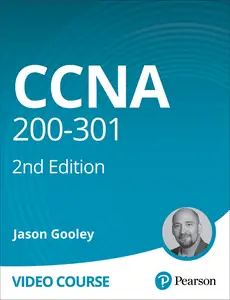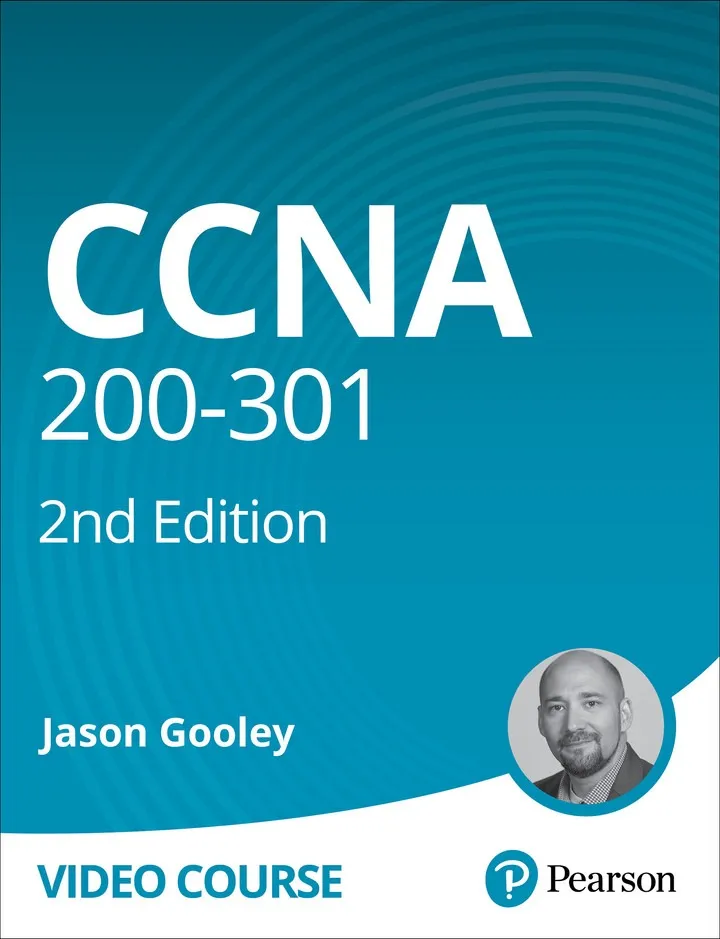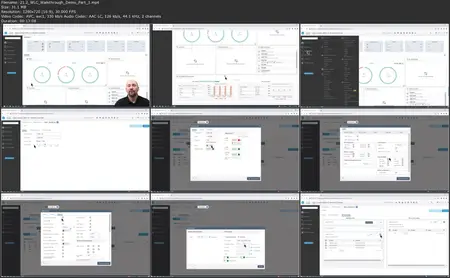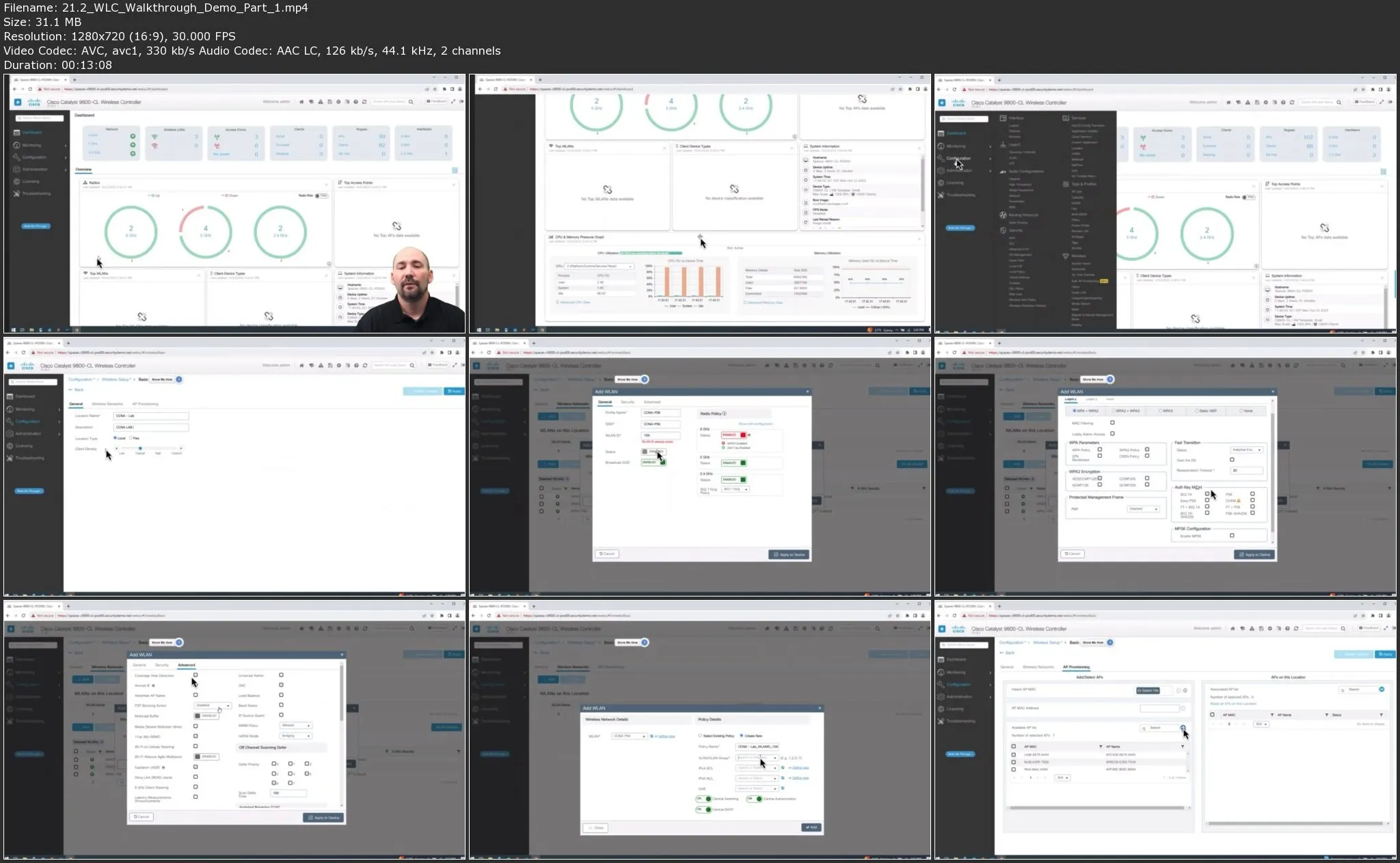CCNA 200-301, 2nd Edition
ISBN: 0138213496 | .MP4, AVC, 1280x720, 30 fps | English, AAC, 2 Ch | 32h 35m | 7.39 GB
Instructor: Jason Gooley
ISBN: 0138213496 | .MP4, AVC, 1280x720, 30 fps | English, AAC, 2 Ch | 32h 35m | 7.39 GB
Instructor: Jason Gooley
Introduction
CCNA 200-301: Introduction
Module 1: Introduction to Network Components and Operations
Module Introduction
Lesson 1: Network Components, Devices, and Functionality
Learning objectives
1.1 Introduction to Routers and Routing Concepts
1.2 Introduction to Switching and the Benefits of Switches
1.3 Overview of Next-Generation Firewalls, IPS, and Common Placement
1.4 Wireless Access Points and the Shift from Wired to Wireless
1.5 Controller Concepts and Overview
1.6 What Is an Endpoint?
1.7 Servers, Storage, and Cloud, Oh My!
1.8 The OSI Model, Its Importance, and Tying It All Together
1.9 Frame or Packet, That IS the Question!
Lesson 2: Common Network Architectures and Design Scenarios
Learning objectives
2.1 Three-Tier (Hierarchical) Architectures
2.2 Two-Tier (Collapsed Core) Architectures
2.3 Basic Network Design Concepts
2.4 Fabric Components
2.5 Wide Area Network (WAN) Concepts
2.6 Small Office/Home Office (SOHO)
2.7 SaaS and IaaS Infrastructure Models
Lesson 3: Understanding Physical Interface Types, Cabling, and Connectivity Methods
Learning objectives
3.1 Single-Mode Fiber (SMF), Multimode Fiber (MMF), Copper (RJ45 and Twisted-Pair)
3.2 Connections (Ethernet Shared Media and Point-to-Point)
3.3 Concepts of Power over Ethernet (PoE, PoE+, UPoE, UPoE+)
Lesson 4: Foundational Switching Concepts and Traffic Forwarding
Learning objectives
4.1 MAC Learning and Aging
4.2 Frame Switching
4.3 Frame Flooding
4.4 MAC Address Table
4.5 Switching and Forwarding Lab Walkthrough
Lesson 5: How to Leverage Layer 2 Discovery Protocols
Learning objectives
5.1 Cisco Discovery Protocol
5.2 Link Layer Discovery Protocol
5.3 CDP/LLDP Lab Walkthrough
Module 2: Understanding Inter-Switch Communication Methods
Module Introduction
Lesson 6: Understanding Virtual Local Area Networks (VLAN) Operations and Configuration
Learning objectives
6.1 Access Ports (Data and Voice)
6.2 Default VLAN
6.3 Connectivity
6.4 VLAN/Access Port Lab Walkthrough
Lesson 7: EtherChannel Fundamentals
Learning objectives
7.1 Understanding EtherChannel and EtherChannel Load Balancing
7.2 Layer 2 vs Layer 3
7.3 Link Aggregation Control Protocol (LACP)
7.4 EtherChannel Lab Walkthrough
Lesson 8: Trunking and Inter-Switch Connectivity Concepts
Learning objectives
8.1 Trunk Ports
8.2 802.1Q Trunking Protocol
8.3 Native VLAN and Understanding Untagged Traffic
8.4 Trunking Overview Lab Walkthrough
Lesson 9: Rapid PVST+ Spanning Tree Protocol Operations
Learning objectives
9.1 Spanning Tree Overview
9.2 IEEE vs. Cisco
9.3 Spanning Tree Operations
9.4 Root Port, Root Bridge (Primary/Secondary)
9.5 Designated Ports and Alternate Ports
9.6 RPVST+ Port States
9.7 PortFast Benefits and Examples
9.8 Spanning Tree Overview Lab Walkthrough
Lesson 10: Troubleshooting Common Interface Connectivity Issues
Learning objectives
10.1 Collisions
10.2 Errors
10.3 Mismatch Duplex
10.4 Speed
10.5 Interface Statistics Lab Walkthrough
Lesson 11: TCP or UDP? Reliable or Unreliable? That IS the Question!
Learning objectives
11.1 TCP
11.2 UDP
Module 3: Introduction to Subnetting, Routing, and Connectivity Essentials
Module Introduction
Lesson 12: IPv4 Addressing and Subnetting Fundamentals
Learning objectives
12.1 IPv4 Addressing Overview
12.2 Decimal to Binary Conversion Overview
12.3 IPv4 Network and Host Addresses
12.4 Understanding Broadcast Addresses
12.5 RFC1918 Addressing and Usage
12.6 How to Calculate Available Subnets and Available Hosts
12.7 IPv4 Subnetting Practice Drills
12.8 IPv4 Addressing and Subnetting Lab Walkthrough: Part 1
12.9 IPv4 Addressing and Subnetting Lab Walkthrough: Part 2
12.10 IPv4 Addressing and Subnetting Lab Walkthrough: Part 3
Lesson 13: First Hop Redundancy Protocols (FHRPs) What Are They?
Learning objectives
13.1 FHRP Overview and Use Cases
13.2 HSRP, VRRP, and GLBP Overview
13.3 FHRP Routing Lab Walkthrough: Part 1
13.4 FHRP Routing Lab Walkthrough: Part 2
Lesson 14: How to Configure Client OS IP Parameters (Windows, macOS, Linux)
Learning objectives
14.1 Windows Lab Walkthrough
14.2 macOS Lab Walkthrough
14.3 Linux Lab Walkthrough
Lesson 15: Routing Table Components and Overview
Learning objectives
15.1 Covering the Bases with RIB, FIB and Destination-based Routing
15.2 Prefixes, Routes, Summaries, and Network Masks
15.3 Next Hops, Administrative Distance, Metrics, and the Gateway of Last Resort
15.4 IP Connectivity Lab Walkthrough: Part 1
15.5 IP Connectivity Lab Walkthrough: Part 2
15.6 IP Connectivity Lab Walkthrough: Part 3
15.7 IP Connectivity Lab Walkthrough: Part 4
Lesson 16: Understanding Routing Concepts
Learning objectives
16.1 Longest Match
16.2 AD and Routing Protocol Metrics
Lesson 17: Static Routing for IPv4
Learning objectives
17.1 Default, Network, Host, and Floating Static Routes
17.2 IPv4 Static Routing Lab Walkthrough
Lesson 18: OSPFv2 Fundamentals
Learning objectives
18.1 Neighbor Formation
18.2 Network Types
18.3 LSAs, Neighbor Adjacencies, and Router ID Significance
18.4 Single Area vs. Multi-Area, Flooding and Fault Domains
18.5 OSPFv2 Routing Lab Walkthrough: Part 1
18.6 OSPFv2 Routing Lab Walkthrough: Part 2
Lesson 19: IPv6 Fundamentals
Learning objectives
19.1 IPv6 Address Types
19.2 Static Routing for IPv6
19.3 IPv6 Address Comparison Drills
19.4 IPv6 Addressing and Prefix Lab: Part 1
19.5 IPv6 Addressing and Prefix Lab: Part 2
19.6 IPv6 Addressing and Prefix Lab: Part 3
Module 4: Wireless Fundamentals and Overview
Module Introduction
Lesson 20: Cisco Wireless Architectures and AP Modes and Connections
Learning objectives
20.1 Typical Wireless Architectures
20.2 WLAN Physical Infrastructure Connections and Components
20.3 AP Modes
20.4 Wireless LAN Controllers
20.5 AP and WLC Management Access Connections
20.6 FlexConnect and EWC
Lesson 21: Leveraging the WLAN Configuration GUI to Setup Client Connectivity
Learning objectives
21.1 Wireless Security Protocols (WPA, WPA2, and WPA3)
21.2 WLC Walkthrough Demo: Part 1
21.3 WLC Walkthrough Demo: Part 2
Module 5: IP Services
Module Introduction
Lesson 22: Network Address Translation (NAT) Overview and Use Cases
Learning objectives
22.1 NAT Translation
22.2 Dynamic NAT Configuration
22.3 Port Address Translation (PAT)
22.4 NAT Lab Walkthrough: Part 1
22.5 NAT Lab Walkthrough: Part 2
22.6 NAT Lab Walkthrough: Part 3
Lesson 23: Network Time Protocol (NTP)
Learning objectives
23.1 Network Time Accuracy, Client/Server Mode Operations, and Stratum
23.2 NTP Lab Walkthrough
Lesson 24: Dynamic Host Configuration Protocol (DHCP)
Learning objectives
24.1 DHCP Messages, Operations, Configuration, Client, and Relay
24.2 DHCP Lab Walkthrough
Lesson 25: DNS Operations and Overview
Learning objectives
25.1 Port 53
25.2 DNS Functionality
Lesson 26: Simple Network Management Protocol
Learning objectives
26.1 SNMP Use Cases and Benefits
26.2 Configuring SNMP
26.3 Enabling SNMP Traps
26.4 SNMP Walkthrough
Lesson 27: Basic SYSLOG Concepts and Use Cases
Learning objectives
27.1 Facilities and Levels
27.2 Server Configuration, Traps, and the logging buffered Command
27.3 SYSLOG Lab Walkthrough
Lesson 28: Quality of Service (QoS) Overview
Learning objectives
28.1 QoS Fundamentals
28.2 Per Hop Behavior (PHB) and Drop Probability Explained
28.3 QoS Models for Classification
28.4 QoS Congestion Management and Avoidance
28.5 QoS Lab
Lesson 29: Remote Access Configuration Using Secure Shell (SSH)
Learning objectives
29.1 SSH Fundamentals
29.2 SSH Lab Walkthrough
Lesson 30: Device File Management Protocols
Learning objectives
30.1 FTP, SFTP, and TFTP
30.2 IP Services Lab Walkthrough
Module 6: Security Fundamentals
Module Introduction
Lesson 31: Understanding Key Security Concepts
Learning objectives
31.1 Threats and Vulnerabilities
31.2 Mitigation Techniques
Lesson 32: Importance of Security Programs
Learning objectives
32.1 User Security Awareness
32.2 End User Training
32.3 Physical Security and Access Control
32.4 Device Access Control Using Local Usernames and Passwords
Lesson 33: Security Policy Elements
Learning objectives
33.1 Password Management
33.2 Complexity
33.3 Password Alternatives
Lesson 34: Virtual Private Networks (VPNs)
Learning objectives
34.1 Remote Access
34.2 Site-to-Site VPNs
Lesson 35: Access Control Lists (ACLs)
Learning objectives
35.1 Standard, Extended, and Named ACLs
35.2 ACL Use Cases
35.3 ACL Lab Walkthrough
Lesson 36: Layer 2 Security Features
Learning objectives
36.1 DHCP Snooping and Dynamic ARP Inspection (DAI)
36.2 Port Security
36.3 DAI Lab Walkthrough
36.4 Port Security Lab Walkthrough
Lesson 37: Authentication, Authorization, and Accounting Concepts
Learning objectives
37.1 AAA Overview
37.2 AAA Lab Walkthrough
Module 7: Automation and Programmability
Module Introduction
Lesson 38: Software Defined Networking Concepts
Learning objectives
38.1 Traditional vs. Controller-based Networks
38.2 Northbound and Southbound APIs
38.3 Software-Defined Architectures (Overlay, Underlay, and Fabric): Part 1
38.4 Software-Defined Architectures (Overlay, Underlay, and Fabric): Part 2
38.5 Control Plane, Data Plane, and Management Plane
Lesson 39: Cisco Catalyst Center Overview
Learning objectives
39.1 Inventory, Design, and Provisioning
39.2 Device Management and Software Image Management (SWIM)
39.3 Assurance and Application Policy (QoS)
39.4 Cisco Catalyst Center Walkthrough: Part 1
39.5 Cisco Catalyst Center Walkthrough: Part 2
39.6 Cisco Catalyst Center Walkthrough: Part 3
Lesson 40: Benefits of Network Programmability and Automation
Learning objectives
40.1 Automation and Network Programmability Overview: Part 1
40.2 Automation and Network Programmability Overview: Part 2
40.3 API Fundamentals
40.4 CRUD Functions
40.5 HTTP Verbs and Response Codes
40.6 Data Encoding Formats: Part 1
40.7 Data Encoding Formats: Part 2
40.8 On-Box vs. Off-Box Automation Tools
40.9 On-Box vs. Off-Box Automation Tools Lab Walkthrough
40.10 Introduction to Ansible
40.11 Introduction to Terraform
Summary
CCNA 200-301: Summary
CCNA 200-301: Introduction
Module 1: Introduction to Network Components and Operations
Module Introduction
Lesson 1: Network Components, Devices, and Functionality
Learning objectives
1.1 Introduction to Routers and Routing Concepts
1.2 Introduction to Switching and the Benefits of Switches
1.3 Overview of Next-Generation Firewalls, IPS, and Common Placement
1.4 Wireless Access Points and the Shift from Wired to Wireless
1.5 Controller Concepts and Overview
1.6 What Is an Endpoint?
1.7 Servers, Storage, and Cloud, Oh My!
1.8 The OSI Model, Its Importance, and Tying It All Together
1.9 Frame or Packet, That IS the Question!
Lesson 2: Common Network Architectures and Design Scenarios
Learning objectives
2.1 Three-Tier (Hierarchical) Architectures
2.2 Two-Tier (Collapsed Core) Architectures
2.3 Basic Network Design Concepts
2.4 Fabric Components
2.5 Wide Area Network (WAN) Concepts
2.6 Small Office/Home Office (SOHO)
2.7 SaaS and IaaS Infrastructure Models
Lesson 3: Understanding Physical Interface Types, Cabling, and Connectivity Methods
Learning objectives
3.1 Single-Mode Fiber (SMF), Multimode Fiber (MMF), Copper (RJ45 and Twisted-Pair)
3.2 Connections (Ethernet Shared Media and Point-to-Point)
3.3 Concepts of Power over Ethernet (PoE, PoE+, UPoE, UPoE+)
Lesson 4: Foundational Switching Concepts and Traffic Forwarding
Learning objectives
4.1 MAC Learning and Aging
4.2 Frame Switching
4.3 Frame Flooding
4.4 MAC Address Table
4.5 Switching and Forwarding Lab Walkthrough
Lesson 5: How to Leverage Layer 2 Discovery Protocols
Learning objectives
5.1 Cisco Discovery Protocol
5.2 Link Layer Discovery Protocol
5.3 CDP/LLDP Lab Walkthrough
Module 2: Understanding Inter-Switch Communication Methods
Module Introduction
Lesson 6: Understanding Virtual Local Area Networks (VLAN) Operations and Configuration
Learning objectives
6.1 Access Ports (Data and Voice)
6.2 Default VLAN
6.3 Connectivity
6.4 VLAN/Access Port Lab Walkthrough
Lesson 7: EtherChannel Fundamentals
Learning objectives
7.1 Understanding EtherChannel and EtherChannel Load Balancing
7.2 Layer 2 vs Layer 3
7.3 Link Aggregation Control Protocol (LACP)
7.4 EtherChannel Lab Walkthrough
Lesson 8: Trunking and Inter-Switch Connectivity Concepts
Learning objectives
8.1 Trunk Ports
8.2 802.1Q Trunking Protocol
8.3 Native VLAN and Understanding Untagged Traffic
8.4 Trunking Overview Lab Walkthrough
Lesson 9: Rapid PVST+ Spanning Tree Protocol Operations
Learning objectives
9.1 Spanning Tree Overview
9.2 IEEE vs. Cisco
9.3 Spanning Tree Operations
9.4 Root Port, Root Bridge (Primary/Secondary)
9.5 Designated Ports and Alternate Ports
9.6 RPVST+ Port States
9.7 PortFast Benefits and Examples
9.8 Spanning Tree Overview Lab Walkthrough
Lesson 10: Troubleshooting Common Interface Connectivity Issues
Learning objectives
10.1 Collisions
10.2 Errors
10.3 Mismatch Duplex
10.4 Speed
10.5 Interface Statistics Lab Walkthrough
Lesson 11: TCP or UDP? Reliable or Unreliable? That IS the Question!
Learning objectives
11.1 TCP
11.2 UDP
Module 3: Introduction to Subnetting, Routing, and Connectivity Essentials
Module Introduction
Lesson 12: IPv4 Addressing and Subnetting Fundamentals
Learning objectives
12.1 IPv4 Addressing Overview
12.2 Decimal to Binary Conversion Overview
12.3 IPv4 Network and Host Addresses
12.4 Understanding Broadcast Addresses
12.5 RFC1918 Addressing and Usage
12.6 How to Calculate Available Subnets and Available Hosts
12.7 IPv4 Subnetting Practice Drills
12.8 IPv4 Addressing and Subnetting Lab Walkthrough: Part 1
12.9 IPv4 Addressing and Subnetting Lab Walkthrough: Part 2
12.10 IPv4 Addressing and Subnetting Lab Walkthrough: Part 3
Lesson 13: First Hop Redundancy Protocols (FHRPs) What Are They?
Learning objectives
13.1 FHRP Overview and Use Cases
13.2 HSRP, VRRP, and GLBP Overview
13.3 FHRP Routing Lab Walkthrough: Part 1
13.4 FHRP Routing Lab Walkthrough: Part 2
Lesson 14: How to Configure Client OS IP Parameters (Windows, macOS, Linux)
Learning objectives
14.1 Windows Lab Walkthrough
14.2 macOS Lab Walkthrough
14.3 Linux Lab Walkthrough
Lesson 15: Routing Table Components and Overview
Learning objectives
15.1 Covering the Bases with RIB, FIB and Destination-based Routing
15.2 Prefixes, Routes, Summaries, and Network Masks
15.3 Next Hops, Administrative Distance, Metrics, and the Gateway of Last Resort
15.4 IP Connectivity Lab Walkthrough: Part 1
15.5 IP Connectivity Lab Walkthrough: Part 2
15.6 IP Connectivity Lab Walkthrough: Part 3
15.7 IP Connectivity Lab Walkthrough: Part 4
Lesson 16: Understanding Routing Concepts
Learning objectives
16.1 Longest Match
16.2 AD and Routing Protocol Metrics
Lesson 17: Static Routing for IPv4
Learning objectives
17.1 Default, Network, Host, and Floating Static Routes
17.2 IPv4 Static Routing Lab Walkthrough
Lesson 18: OSPFv2 Fundamentals
Learning objectives
18.1 Neighbor Formation
18.2 Network Types
18.3 LSAs, Neighbor Adjacencies, and Router ID Significance
18.4 Single Area vs. Multi-Area, Flooding and Fault Domains
18.5 OSPFv2 Routing Lab Walkthrough: Part 1
18.6 OSPFv2 Routing Lab Walkthrough: Part 2
Lesson 19: IPv6 Fundamentals
Learning objectives
19.1 IPv6 Address Types
19.2 Static Routing for IPv6
19.3 IPv6 Address Comparison Drills
19.4 IPv6 Addressing and Prefix Lab: Part 1
19.5 IPv6 Addressing and Prefix Lab: Part 2
19.6 IPv6 Addressing and Prefix Lab: Part 3
Module 4: Wireless Fundamentals and Overview
Module Introduction
Lesson 20: Cisco Wireless Architectures and AP Modes and Connections
Learning objectives
20.1 Typical Wireless Architectures
20.2 WLAN Physical Infrastructure Connections and Components
20.3 AP Modes
20.4 Wireless LAN Controllers
20.5 AP and WLC Management Access Connections
20.6 FlexConnect and EWC
Lesson 21: Leveraging the WLAN Configuration GUI to Setup Client Connectivity
Learning objectives
21.1 Wireless Security Protocols (WPA, WPA2, and WPA3)
21.2 WLC Walkthrough Demo: Part 1
21.3 WLC Walkthrough Demo: Part 2
Module 5: IP Services
Module Introduction
Lesson 22: Network Address Translation (NAT) Overview and Use Cases
Learning objectives
22.1 NAT Translation
22.2 Dynamic NAT Configuration
22.3 Port Address Translation (PAT)
22.4 NAT Lab Walkthrough: Part 1
22.5 NAT Lab Walkthrough: Part 2
22.6 NAT Lab Walkthrough: Part 3
Lesson 23: Network Time Protocol (NTP)
Learning objectives
23.1 Network Time Accuracy, Client/Server Mode Operations, and Stratum
23.2 NTP Lab Walkthrough
Lesson 24: Dynamic Host Configuration Protocol (DHCP)
Learning objectives
24.1 DHCP Messages, Operations, Configuration, Client, and Relay
24.2 DHCP Lab Walkthrough
Lesson 25: DNS Operations and Overview
Learning objectives
25.1 Port 53
25.2 DNS Functionality
Lesson 26: Simple Network Management Protocol
Learning objectives
26.1 SNMP Use Cases and Benefits
26.2 Configuring SNMP
26.3 Enabling SNMP Traps
26.4 SNMP Walkthrough
Lesson 27: Basic SYSLOG Concepts and Use Cases
Learning objectives
27.1 Facilities and Levels
27.2 Server Configuration, Traps, and the logging buffered Command
27.3 SYSLOG Lab Walkthrough
Lesson 28: Quality of Service (QoS) Overview
Learning objectives
28.1 QoS Fundamentals
28.2 Per Hop Behavior (PHB) and Drop Probability Explained
28.3 QoS Models for Classification
28.4 QoS Congestion Management and Avoidance
28.5 QoS Lab
Lesson 29: Remote Access Configuration Using Secure Shell (SSH)
Learning objectives
29.1 SSH Fundamentals
29.2 SSH Lab Walkthrough
Lesson 30: Device File Management Protocols
Learning objectives
30.1 FTP, SFTP, and TFTP
30.2 IP Services Lab Walkthrough
Module 6: Security Fundamentals
Module Introduction
Lesson 31: Understanding Key Security Concepts
Learning objectives
31.1 Threats and Vulnerabilities
31.2 Mitigation Techniques
Lesson 32: Importance of Security Programs
Learning objectives
32.1 User Security Awareness
32.2 End User Training
32.3 Physical Security and Access Control
32.4 Device Access Control Using Local Usernames and Passwords
Lesson 33: Security Policy Elements
Learning objectives
33.1 Password Management
33.2 Complexity
33.3 Password Alternatives
Lesson 34: Virtual Private Networks (VPNs)
Learning objectives
34.1 Remote Access
34.2 Site-to-Site VPNs
Lesson 35: Access Control Lists (ACLs)
Learning objectives
35.1 Standard, Extended, and Named ACLs
35.2 ACL Use Cases
35.3 ACL Lab Walkthrough
Lesson 36: Layer 2 Security Features
Learning objectives
36.1 DHCP Snooping and Dynamic ARP Inspection (DAI)
36.2 Port Security
36.3 DAI Lab Walkthrough
36.4 Port Security Lab Walkthrough
Lesson 37: Authentication, Authorization, and Accounting Concepts
Learning objectives
37.1 AAA Overview
37.2 AAA Lab Walkthrough
Module 7: Automation and Programmability
Module Introduction
Lesson 38: Software Defined Networking Concepts
Learning objectives
38.1 Traditional vs. Controller-based Networks
38.2 Northbound and Southbound APIs
38.3 Software-Defined Architectures (Overlay, Underlay, and Fabric): Part 1
38.4 Software-Defined Architectures (Overlay, Underlay, and Fabric): Part 2
38.5 Control Plane, Data Plane, and Management Plane
Lesson 39: Cisco Catalyst Center Overview
Learning objectives
39.1 Inventory, Design, and Provisioning
39.2 Device Management and Software Image Management (SWIM)
39.3 Assurance and Application Policy (QoS)
39.4 Cisco Catalyst Center Walkthrough: Part 1
39.5 Cisco Catalyst Center Walkthrough: Part 2
39.6 Cisco Catalyst Center Walkthrough: Part 3
Lesson 40: Benefits of Network Programmability and Automation
Learning objectives
40.1 Automation and Network Programmability Overview: Part 1
40.2 Automation and Network Programmability Overview: Part 2
40.3 API Fundamentals
40.4 CRUD Functions
40.5 HTTP Verbs and Response Codes
40.6 Data Encoding Formats: Part 1
40.7 Data Encoding Formats: Part 2
40.8 On-Box vs. Off-Box Automation Tools
40.9 On-Box vs. Off-Box Automation Tools Lab Walkthrough
40.10 Introduction to Ansible
40.11 Introduction to Terraform
Summary
CCNA 200-301: Summary





